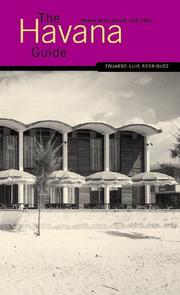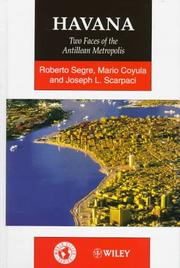| Listing 1 - 10 of 13 | << page >> |
Sort by
|
Dissertation
ISBN: 3878213336 Year: 2007 Publisher: München : Dep. für Geographie der Univ. München,
Abstract | Keywords | Export | Availability | Bookmark
 Loading...
Loading...Choose an application
- Reference Manager
- EndNote
- RefWorks (Direct export to RefWorks)
Landschaftsökologie. --- Raumordnung. --- Umweltpolitik. --- Havanna.
Book
Year: 1978 Publisher: La Habana : Editorial de Ciencias Sociales,
Abstract | Keywords | Export | Availability | Bookmark
 Loading...
Loading...Choose an application
- Reference Manager
- EndNote
- RefWorks (Direct export to RefWorks)
Espagnol (Langue) --- Konsonant. --- Mundart. --- Spanish language --- Dialectes --- Dialects --- Dialects. --- Cuba --- Havanna.
Dissertation
Abstract | Keywords | Export | Availability | Bookmark
 Loading...
Loading...Choose an application
- Reference Manager
- EndNote
- RefWorks (Direct export to RefWorks)
Book
ISBN: 1781386382 1781388822 1846317177 9781846317170 9781846317484 1846317487 Year: 2011 Publisher: Liverpool Liverpool University Press
Abstract | Keywords | Export | Availability | Bookmark
 Loading...
Loading...Choose an application
- Reference Manager
- EndNote
- RefWorks (Direct export to RefWorks)
Cuba℗'s Wild East: A Literary Geography of Oriente recounts a literary history of modern Cuba that has four distinctive and interrelated characteristics. Oriented to the east of the island, it looks aslant at a Cuban national literature that has sometimes been indistinguishable from a history of Havana. Given the insurgent and revolutionary history of that eastern region, it recounts stories of rebellion, heroism, and sacrifice. Intimately related to places and sites which now belong to a national pantheon, its corpus℗-while including fiction and poetry℗-is frequently written as memoir and testimony. As a region of encounter, that corpus is itself resolutely mixed, featuring a significant proportion of writings by US journalists and novelists as well as by Cuban writers.
Cuban literature --- Nationalism in literature. --- History and criticism. --- Havana (Cuba) --- San Cristóbal de la Habana (Cuba) --- Gavana (Cuba) --- Habana (Cuba) --- La Havana (Cuba) --- La Habana (Cuba) --- La Havane (Cuba) --- Havane (Cuba) --- Avana (Cuba) --- In literature. --- Havanna (Cuba) --- Cuba --- 1900-1999

ISBN: 1568982100 Year: 2000 Publisher: New York Princeton Architectural Press
Abstract | Keywords | Export | Availability | Bookmark
 Loading...
Loading...Choose an application
- Reference Manager
- EndNote
- RefWorks (Direct export to RefWorks)
The first half of the twentieth century was a culturally and artistically rich era in Cuba. Architects of the modern movement enthusiastically sought to define the identity of this tine Caribbean nation, and their vision is most notably revealed in the capital city of Havana. This is the first book to recognize and catalog the enormous architectural wealth of Havana built between 1925 and 1965. The guide features 200 structures ranging from private homes to hotels, churches and government buildings. Included are maps organized by neighborhood, archival and contemporary photographs, plans for each building and a brief history of the modern movement in Cuba and the architects responsible for the brilliant diversity of Havana's landscape.
Architecture --- 72.06 --- architectuur --- architectuur 20e eeuw --- architectuurgidsen --- Cuba --- Havana --- stedengidsen --- Architecture, Western (Western countries) --- Building design --- Buildings --- Construction --- Western architecture (Western countries) --- Art --- Building --- History --- stadsarchitectuurgidsen --- Design and construction --- Havana (Cuba) --- San Cristóbal de la Habana (Cuba) --- Gavana (Cuba) --- Habana (Cuba) --- La Havana (Cuba) --- La Habana (Cuba) --- La Havane (Cuba) --- Havane (Cuba) --- Avana (Cuba) --- Buildings, structures, etc. --- anno 1920-1929 --- anno 1930-1939 --- anno 1940-1949 --- anno 1950-1959 --- anno 1960-1969 --- Havanna (Cuba) --- Architecture, Primitive
Book
ISBN: 1442668997 9781442668997 9781442647718 144264771X 9781442615786 1442615788 1442669004 Year: 2014 Publisher: Toronto
Abstract | Keywords | Export | Availability | Bookmark
 Loading...
Loading...Choose an application
- Reference Manager
- EndNote
- RefWorks (Direct export to RefWorks)
For more than thirty years, musician Carlos Varela has been a guide to the heart, soul, and sound of Havana. My Havana is a lyrical exploration of Varela's life and work, and of the vibrant musical, literary, and cinematic culture of his generation.
Popular music --- Songs, Spanish --- Spanish songs --- Music, Popular --- Music, Popular (Songs, etc.) --- Pop music --- Popular songs --- Popular vocal music --- Songs, Popular --- Vocal music, Popular --- Music --- Cover versions --- History and criticism. --- Political aspects --- Varela, Carlos, --- Criticism and interpretation. --- Influence. --- Havana (Cuba) --- San Cristóbal de la Habana (Cuba) --- Gavana (Cuba) --- Habana (Cuba) --- La Havana (Cuba) --- La Habana (Cuba) --- La Havane (Cuba) --- Havane (Cuba) --- Avana (Cuba) --- Social life and customs. --- Havanna (Cuba)

ISBN: 0471949795 Year: 1997
Abstract | Keywords | Export | Availability | Bookmark
 Loading...
Loading...Choose an application
- Reference Manager
- EndNote
- RefWorks (Direct export to RefWorks)
Urbanization --- City planning --- History. --- Havana (Cuba) --- Economic conditions. --- Social conditions. --- Cities and towns, Movement to --- Urban development --- Urban systems --- Cities and towns --- Social history --- Sociology, Rural --- Sociology, Urban --- Urban policy --- Rural-urban migration --- Civic planning --- Land use, Urban --- Model cities --- Redevelopment, Urban --- Slum clearance --- Town planning --- Urban design --- Urban planning --- Land use --- Planning --- Art, Municipal --- Civic improvement --- Regional planning --- Urban renewal --- History --- Government policy --- Management --- San Cristóbal de la Habana (Cuba) --- Gavana (Cuba) --- Habana (Cuba) --- La Havana (Cuba) --- La Habana (Cuba) --- La Havane (Cuba) --- Havane (Cuba) --- Avana (Cuba) --- Havanna (Cuba)
Book
ISBN: 0822986493 9780822986492 9780822945468 0822945460 Year: 2019 Publisher: Pittsburgh, Pa.
Abstract | Keywords | Export | Availability | Bookmark
 Loading...
Loading...Choose an application
- Reference Manager
- EndNote
- RefWorks (Direct export to RefWorks)
"Joseph Hartman focuses on the public works campaign of Cuban president, and later dictator, Gerardo Machado. Political histories often condemn Machado as a US-puppet dictator, overthrown in a labor revolt and popular revolution in 1933. Architectural histories tend to catalogue his regime's public works as derivatives of US and European models. Dictator's Dreamscape reassesses the regime's public works program as a highly nuanced visual project embedded in centuries-old representations of Cuba alongside wider debates on the nature of art and architecture in general, especially in regards to globalization and the spread of US-style consumerism. The cultural production overseen by Machado gives a fresh and greatly broadened perspective on his regime's accomplishments, failures, and crimes. The book addresses the regime's architectural program as a visual and architectonic response to debates over Cuban national identity, US imperialism, and Machado's own cult of personality"--
Public architecture --- Architecture --- Nationalism and architecture --- HISTORY / Latin America / South America. --- Architecture and nationalism --- Nationalism in architecture --- Architecture, Western (Western countries) --- Building design --- Buildings --- Construction --- Western architecture (Western countries) --- Art --- Building --- Architecture, Public --- Civic architecture --- History --- Political aspects --- Design and construction --- Machado y Morales, Gerardo, --- Morales, Gerardo Machado y, --- Machado, Gerardo, --- Art patronage. --- Havana (Cuba) --- San Cristóbal de la Habana (Cuba) --- Gavana (Cuba) --- Habana (Cuba) --- La Havana (Cuba) --- La Habana (Cuba) --- La Havane (Cuba) --- Havane (Cuba) --- Avana (Cuba) --- Buildings, structures, etc. --- Havanna (Cuba) --- Architecture, Primitive
Book
ISBN: 8474839815 Year: 1993 Publisher: Madrid Ministerio de Cultura
Abstract | Keywords | Export | Availability | Bookmark
 Loading...
Loading...Choose an application
- Reference Manager
- EndNote
- RefWorks (Direct export to RefWorks)
Mythology, Greek, in art --- Vases --- Vases, Greek --- Catalogs. --- Private collections --- Catalogs --- Containers --- Urns --- Private collections&delete& --- Gumá, Joaquín, --- Lagunillas, Joaquín Gumá, --- Art collections --- Museo Nacional de Bellas Artes (Cuba) --- Cuba. --- Musée national des beaux-arts de La Havane --- Musée national des beaux-arts (Cuba) --- Museo de Bellas Artes de La Habana --- Museo Nacional de Bellas Artes (Cuba). --- Museo Nacional de Bellas Artes de Cuba --- Museo Nacional Palacio de Bellas Artes (Cuba) --- Museu Nacional de Belles Arts (Cuba) --- Nationalmuseum der Schönen Künste (Cuba) --- Nationalmuseum der Schönen Künste von Havanna --- Nat︠s︡ionalʹnyĭ muzeĭ izi︠a︡shchnykh iskusstv Gavana --- Nat︠s︡ionalʹnyĭ muzeĭ izi︠a︡shchnykh iskusstv (Cuba) --- Palacio de Bellas Artes (Cuba) --- Palacio Nacional de Bellas Artes (Cuba) --- National Museum of Fine Arts (Cuba) --- Museo Nacional de Bellas Artes de la Habana --- Museo Nacional de Cuba --- Vases [Greek ] --- La Habana (Cuba) --- Museo de Bellas Artes de La Habana (Cuba)
Book
ISBN: 1469610892 1469611805 1469610876 1469610884 9781469611808 9781469610894 9781469610870 9781469610887 Year: 2013 Publisher: Chapel Hill
Abstract | Keywords | Export | Availability | Bookmark
 Loading...
Loading...Choose an application
- Reference Manager
- EndNote
- RefWorks (Direct export to RefWorks)
"In Conceiving Freedom, Camillia Cowling shows how gender shaped urban routes to freedom for the enslaved during the process of gradual emancipation in Cuba and Brazil, which occurred only after the rest of Latin America had abolished slavery and even after the American Civil War. Focusing on late nineteenth-century Havana and Rio de Janeiro, Cowling argues that enslaved women played a dominant role in carving out freedom for themselves and their children through the courts. Cowling examines how women, typically illiterate but with access to scribes, instigated myriad successful petitions for emancipation, often using "free-womb" laws that declared that the children of enslaved women were legally free. She reveals how enslaved women's struggles connected to abolitionist movements in each city and the broader Atlantic World, mobilizing new notions about enslaved and free womanhood. She shows how women conceived freedom and then taught the "free-womb" generation to understand and shape the meaning of that freedom. Even after emancipation, freed women would continue to use these claims-making tools as they struggled to establish new spaces for themselves and their families in post emancipation society"--
Women slaves --- Antislavery movements --- History --- Legal status, laws, etc. --- Havana (Cuba) --- Rio de Janeiro (Brazil) --- Race relations --- Abolitionism --- Anti-slavery movements --- Slavery --- Slave women --- San Cristóbal de la Habana (Cuba) --- Gavana (Cuba) --- Habana (Cuba) --- La Havana (Cuba) --- La Habana (Cuba) --- La Havane (Cuba) --- Havane (Cuba) --- Rio-de-Zhaneĭro (Brazil) --- Riyo de Zshaneyro (Brazil) --- Río de Xaneiro (Brazil) --- Prefeitura do Rio (Brazil) --- SOCIAL SCIENCE / Slavery. --- SOCIAL SCIENCE / Women's Studies. --- HISTORY / Latin America / General. --- Human rights movements --- Slaves --- Rio de Žaneiro (Brazil) --- Prefeitura da Cidade do Rio de Janeiro (Brazil) --- Rio (Brazil) --- Município do Rio de Janeiro (Brazil) --- Municipality of Rio de Janeiro (Brazil) --- Avana (Cuba) --- Enslaved women --- Havanna (Cuba)
| Listing 1 - 10 of 13 | << page >> |
Sort by
|

 Search
Search Feedback
Feedback About UniCat
About UniCat  Help
Help News
News